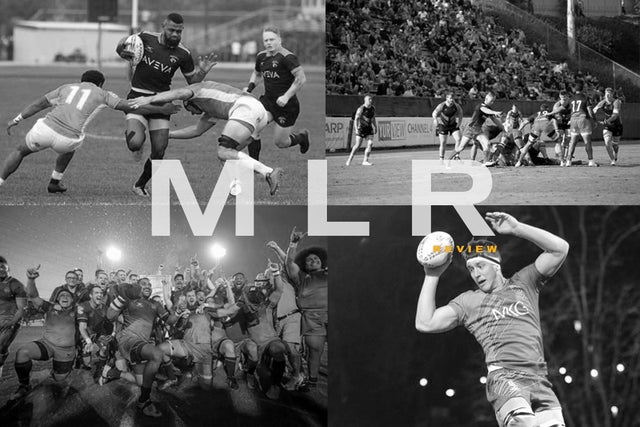MLR Season One a Resounding Success
Written By: Adam McQueen
Now that the dust has settled on an eventful inaugural Major League Rugby season, all eyes are firmly fixed on the future of professional rugby in North America. Although the curtain has only just been drawn on the playoffs and Seattle are exhausting the last drops of their celebratory champagne, there is no time for the competition to rest on their laurels. A fledgling league such as the MLR must be proactive in reflecting upon the strengths and weaknesses of its first season, as well as prepare to deliver an even bigger and better product for rugby fans in 2019. The American sports market is a crowded space that allows no time for stagnation.
So how successful was Major League Rugby, and where do we go from here?
By all accounts, Major League Rugby righted the abhorrent wrongs of its predecessor PRO Rugby. Players and staff were financially compensated (barring some controversial claims in Austin), teams integrated themselves into their local communities, and the on-field product was exciting and relatively strong. These are positive signs, but the benchmark for success should not be comparing oneself to a competition that went bust within the year.
A more enlightening endeavour would be to observe the development of Major League Soccer (MLS), a competition that has battled to earn a foothold in mainstream American sports. Both the successes and shortcomings of the MLS can guide the growth of Major League Rugby.
The MLS has undergone a rapid expansion of teams, from only 10 in 2004, to a projected 28 by 2020. This growth serves as a double edged sword – the game enters into larger markets, brings in revenue through expansion fees, and draws greater viewership across the country. Yet, it simultaneously dilutes the product by a considerable margin and creates an even larger gulf (in skill level and salary demands) between imported international stars and domestic players.
Thankfully, the few projected expansion teams set to join Major League Rugby in 2019 will add immediate value to the league.
New York’s outfit is already a high-quality team that brings a massive market with it and leads professional rugby towards the east coast. The Ontario Arrows – who are on the verge of being the first Canadian team in the competition – enjoyed a successful exhibition season both on and off the field, drumming up considerable interest from fans. Meanwhile, LA and Washington – who are slated for a 2020 entry – are must-have markets where rugby interest is steadily growing. FloRugby’s hint at an Atlanta setup would also bring a strong team into the fold, along with a host of commercial opportunities.
Steadily expanding the league will broaden their scope in the American rugby community, however Major League Rugby will have to toe the line delicately.
There is potential to decrease the quality of rugby by over-saturating the competition with teams. Although the issue of over-expansion may seem in the distant future, it is imperative that Major League Rugby is thorough when broadening their operations. Bigger does not necessarily mean better.
Major League Rugby is in the business of making money. As such, they are not obliged to develop homegrown talent for USA Rugby – ideally the goal should be to attract the best players and have a product that is entertaining for viewers. However, installing a robust development pipeline will be beneficial in raising the standard of play, and weans the league away from being overly reliant on big-name, big-price international players the way that MLS has fallen victim to. Before the season began, Major League Rugby commissioner Dean Howes expressed the competition’s ability to impact grassroots rugby, a sport that most Americans don’t become acquainted with until their late teens.
"Every team in the league is charged with getting into the high schools and improving the high school programs… Working with people to develop better coaches and more accredited coaches," Howes said. "It's going to be a process but we're going to focus and try to influence every one of those bands from youth to high school to club, college, pro.”
There must be a balance; a Quade Cooper sighting will bring in plenty of new fans and credibility, but sinking over 80% of a team’s salary cap into an overseas ‘star’ will come at the expense of the rest of the squad.
Big names drum up initial interest, but the quality of the product will ensure longevity.
The quality of play during the first Major League Rugby season certainly endured ebbs and flows, but the competitiveness and excitement remained consistent. The final served as a microcosm of this; Seattle and Glendale played to a hectic pace, sharing moments of brilliance with passages of play riddled with errors. Nonetheless, the match – which had four lead changes and highlight reel moments – was a delight to watch for the casual rugby fan or newbie to the sport.
This is the best approach Major League Rugby can adopt in order to strengthen their market. Teams were not finely polished as they built their squads on the fly during a condensed season, yet matches were even affairs in which opponents would willingly throw caution to the wind. This unrefined approach felt uniquely American – Major League Rugby was not attempting to emulate other leagues. Major League Rugby commentator and former USA Women’s head coach Pete Steinberg explains that this is best for business.
“There’s a looseness and a willingness to try things. I think that is because in America it is called ‘sports entertainment’, and not just sports,” Steinberg noted during the Rugby Wrap Up show. “All the people that are involved with Major League Rugby know the business that they are in. They would prefer to play a wide open, exciting game that gets more people in the seats than lose and play a boring game.”
The Rugby Wrap Up show – which has been dedicated in its coverage of Major League Rugby – also noted that the league’s structure facilitated free-flowing rugby. The absence of a relegation system enables teams to play without fear of facing the financial burden of being knocked down a tier.
Moreover, the most glaring on-field impact that Major League Rugby had was seen within the USA Eagles resounding June Summer Series success.
The Eagles took a tier one scalp for the first time ever with a one point victory over a young Scotland side, in part thanks to a heavy influence of Major League Rugby talent.
In years past, both the USA and Canada have fielded squads mixing full-time professionals and amateur athletes. Despite some heroic efforts, the lack of depth and fitness within both teams would cause them to falter in the latter moments against bigger countries.
However, with domestic players being immersed in a professional environment, the Eagles were able to lean on their bench to secure the historic victory against Scotland. The sleeping giant of world rugby finally garnered the attention of international fans.
This attention also brings a new set of obstacles for Major League Rugby. The success of the competition has allowed certain stars to shine so brightly that they have generated interest from professional clubs in foreign leagues. In its current state, Major League Rugby cannot financially compete with these teams that vulture their American talent; in this post-season alone Bryce Campbell, Ben Landry, and David Tameilau all secured overseas contracts for 2019.
The salary cap currently sits at $350,000. However, the proposed three team expansion should trigger a slight spike on those numbers.
In order to compete with other professional leagues – both in the United States and within foreign rugby competitions – Major League Rugby teams must invest in themselves. With a full offseason in which to prepare and operate, procuring facilities that enable athletes to maximize their potential and stadiums that will attract a buzzing fan atmosphere should be at the forefront of team’s minds. The quality of sporting venues was the most disparate element of the competition. Glendale, Utah, and Seattle all played in strong setups with a full crowd in attendance, while Houston and NOLA competed in front of sparse high school bleachers. As such, the Houston Sabercats recent announcement outlining their projected stadium for 2019 is cause for celebration.
The next six months leading into season two of Major League Rugby is an opportunity to create even more buzz as three large markets potentially enter the fray. As a die-hard rugby fan, overseas professional leagues have done a poor job in their coverage of player transactions and new signings.
In contrast, North American sports leagues have been able to use free agency, player signings, and trades during the offseason to maintain fan interest. In fact, this coverage can cause off-season interest to even supersede the actual season! Major League Rugby cannot fade into darkness until January 26th and anticipate a larger following upon its reemergence.
There is a solid foundation for Major League Rugby to grow. The league is also keenly aware, and even anticipated, the flaws of their shortened inaugural season. Facilities and fan bases should strengthen over time. However, the single-entity structure of the league must ensure that each team is pulling their weight. With expansion on the horizon consisting of teams that will certainly add value to the league, there is little doubt that Major League Rugby will take several steps forward in 2019.


